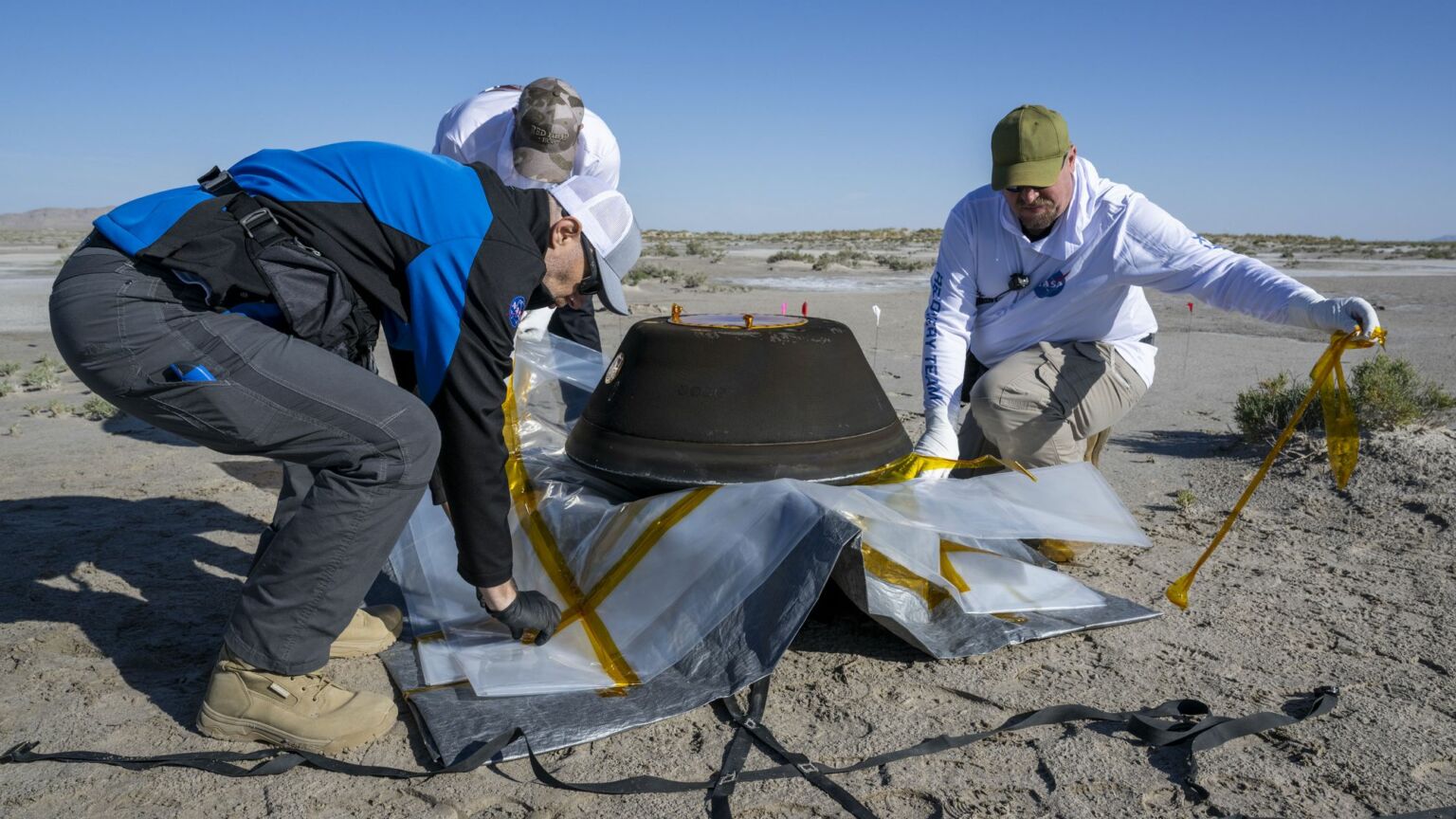Uncovering the secrets of our solar system
Studying the Bennu asteroid will help humanity understand its past and shape its future.

Want to read spiked ad-free? Become a spiked supporter.
It’s like something out of a science-fiction movie. A capsule no bigger than an Amazon parcel crashed from space into the Utah desert a few weeks ago. There, a crowd of scientists waited to get their hands on its contents – the largest asteroid sample ever recovered. This event marks the latest dispatch from the ever-expanding story of humanity’s origins and possible future.
The chunks of dust and rock were taken from the asteroid 101955 Bennu, a spinning-top-shaped lump of space rock weighing over 70 billion kilograms, and measuring only 500 metres across. It is hurtling through a region of space 96million miles away at around 64,000 miles per hour.
The sample was recovered by NASA’s probe called OSIRIS-Rex, which stands for ‘Origins, Spectral Interpretation, Resource Identification, Security, Regolith Explorer’. Launched in 2016, OSIRIS began mapping the asteroid in 2018.
In 2020, in an ingenious and groundbreaking manoeuvre, known as ‘touch and go’, OSIRIS unfurled a robotic arm before briefly touching down on the speeding asteroid and scooping up dust and pebbles from its surface. The material was then stored in its capsule for OSIRIS’s three-year journey back to Earth. Having jettisoned its precious payload, OSIRIS will now travel on to observe another asteroid.
As a wandering object in the night sky, Bennu has been known to astronomers for centuries. It makes approximately annual trips around the Sun, but, because of the eccentricity of its orbit, comes closer to Earth every six years.
On 11 September 1999, Bennu came approximately 20 Earth-to-Moon distances close to us. Scientists took the opportunity of its next close pass, during 2005 and 2007, to carry out a host of observations. As a result, they were able to determine the asteroid’s temperature and brightness.
During the 2010s, scientists refined the data on Bennu’s speed, orbit, rotation period and shape. Bennu was of particular interest because it forms part of the Apollo asteroid group, the contents of which have orbits that overlap with the Earth’s. That means there’s a chance – almost one in 3,000 – of Bennu colliding with the Earth in 150 years’ time. For now, though, it won’t come quite as close to Earth again as it did in 2020 until 2060, making this an ideal time to obtain more information on the celestial visitor.
Scientists have already been surprised to discover that the surface of Bennu is not made from hard rock, as asteroids are often portrayed in sci-fi movies like Armageddon. Instead, data from OSIRIS reveal that Bennu’s exterior is made of loosely packed particles only lightly bound to each other. A person stepping on Bennu would feel like they were stepping into a children’s ball pit.
Data like this help improve theories on how asteroids move and break up. We can now significantly update our thinking on what would happen if one were to come too close to Earth for comfort. Or even how we might go about destroying one.
Yet an even more exciting story to be told by the OSIRIS mission does not concern the potential doom that could befall humanity. Rather, Bennu could provide answers as to how we came to exist in the first place. The discoveries waiting to be unlocked from the Bennu sample will provide crucial clues as to how our solar system formed and how life began.
Bennu is a carbonaceous type of asteroid, which means that it contains organic compounds. Analysing the properties of these complex molecules will yield far more fine-grain detail than the kind of remote spectral analysis usually undertaken on space bodies. It will provide something akin to a ‘core-sample’ of the conditions that prevailed as the disc of debris surrounding our young Sun formed into planets, asteroids and other objects five billion years ago.
The data will also hopefully begin to answer one of the great mysteries about how life began on Earth – namely, how the water that covers 70 per cent of the planet came to be here. It is hoped that analysing traces of water within the composition of Bennu may establish whether asteroid collisions on the early Earth were the source.
There is yet another tantalising possibility raised by the Bennu research. It could establish that water and the specific organic compounds necessary for life might not have developed, as is commonly supposed, through random processes on primordial Earth. They might instead have already been present at the origins of the solar system and have been distributed throughout space. This could mean that life, including human-like life, is a lot more prevalent throughout the cosmos than we have previously thought.
Either way, the Bennu mission promises to hugely advance human knowledge of our origins and perhaps even our future. It’s a remarkable achievement. And it provides yet further proof of what spiked has always advocated – that humanity is underrated.
Gareth Sturdy is a physics adviser and former teacher.
Picture by: Getty.
Who funds spiked? You do
We are funded by you. And in this era of cancel culture and advertiser boycotts, we rely on your donations more than ever. Seventy per cent of our revenue comes from our readers’ donations – the vast majority giving just £5 per month. If you make a regular donation – of £5 a month or £50 a year – you can become a and enjoy:
–Ad-free reading
–Exclusive events
–Access to our comments section
It’s the best way to keep spiked going – and growing. Thank you!









Comments
Want to join the conversation?
Only spiked supporters and patrons, who donate regularly to us, can comment on our articles.